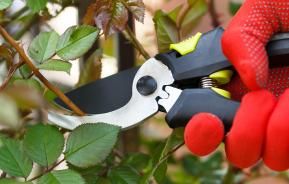Why do you need to prune roses?
Pruning roses involves removing dead, diseased and dying stems to help improve plant hygiene, health and appearance. While you might think they can fend for themselves without much human intervention, pruning and doing other small maintenance tasks for your roses can help them grow to their optimum potential.
You can also shape the plant to help it fit better with its environment and to avoid overcrowding. By removing dead or dying material you will help the plant put its energy into its healthy growth.
When to prune roses
The majority of roses in the UK are pruned in late winter during February and early March before leaf buds are starting to swell, but this normally depends on your climate and where you are.
In the south
In the south you are safest to prune roses in late February just as the new growth begins on rose plants.
In the north
If you live in the north and other colder areas of the UK we would recommend waiting until late March before pruning roses.
Ground cover, shrub, patio, miniature
Ground cover, shrub, patio, miniature, floribunda and hybrid tea roses can all be pruned during the late winter months. Deadheading roses is recommended after flowering to help preserve the plant’s energies and promote growth, unless you want the hips left for decoration.
How to prune roses
When it comes time to prune your roses, make sure you:
Use clean tools
It is important to use clean tools for this task as roses are susceptible to disease through open wounds.
Make your cuts up to 5mm
Do so above an existing bud with clean, sharp gardening secateurs. Any closer than this and your plant might find it difficult to produce new growth from this stem.
Angle your cut away from the rose plant
This prevents rain water from dripping towards it and collecting to cause disease.
Start by pruning dead, diseased or dying stems
Also clear out any unnecessary or un-shapely stems. If you are looking for an open shape then concentrate your pruning on the outward facing rose buds. If you would prefer an upright growth shape then prune above the inward facing buds.
Cut out woody stems that do not produce flowers
On an older, well established rose you can afford to use a bit of tough love. Cut out the woody stems that do not produce flowers. You can use a small saw for this if the stems are very thick.
Climbing and rambling roses are different
Climbing and rambling roses are slightly different, and will need care that’s specific to the type of plant. In this section we look at when and how to prune climbing roses and rambling roses. roses.

Pruning climbing roses
Between November and February, prune side shoots on climbing roses. With these, leave the main framework as it is, unless they have grown past the wall or support that is in place. Remember when pruning the side shoots, you’ll need to cut just above the bud that is facing the direction that you’d like the new stem to grow in. Once pruned, tie any stems to the support so they are in prime position for flowering.
Pruning rambling roses
Unlike most other rose types, rambling roses should be pruned straight after flowering from July to August. Leaving them unpruned can result in a messy appearance of branches and not many flowers. Unlike climbing roses, rambling roses tend to flower once around June. So when the flowers have been deadheaded, pruning should be carried out.
If their support, such as the pergola or arbour, has been covered, one in three of the oldest stems can be completely removed. Any side shoots can be pruned back, leaving around one third in place.
Pruning patio and miniature roses
Potted patio roses are shorter, compact flowering bush roses, which can be pruned by cutting back twiggy stems and reducing the main stems down by one-third.
Patio roses are best pruned in late winter when growth is kickstarting. February is prime time in milder areas of the UK, but in colder regions March is best. This is also the time to remove shoots to keep the shape intact.
Similarly, weak and twiggy growth of miniature roses can be cut back to encourage new shoots at the same time you prune your patio roses. Also pruning older growth down to near soil level can be beneficial too. Doing this encourages strong growth from the base of the plant.
What if I don’t know what type of rose I have?
If you are unable to identify the type of rose plant you are about to prune there are a few ways around your dilemma.
Climbing or rambling roses
Climbing or rambling roses tend to have long stems and you should aim to cut the older woody stems low down at the base of the rose plant.
The smaller rose bushes and shrubs
These smaller roses have much more delicate stems and pruning should again be as low to ground level as possible. You can prune newer or greener stems and these bark covered shoots should be cut at the sides.
Either way, if you are in any doubt about when to prune roses, stick to February to March, the most common pruning time for roses.
To learn more about planting roses, growing roses and caring for roses, discover more of our helpful guides in the advice and inspiration section of our website. And view our rose-related products to cover all your essential rose needs, from rose feed to compost and specialist rose spray.










